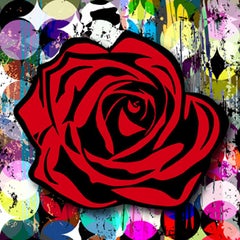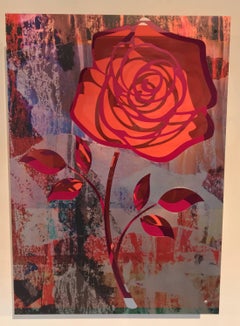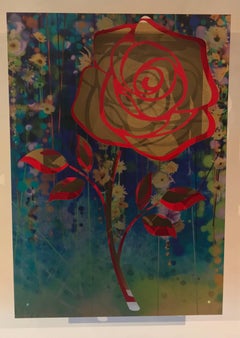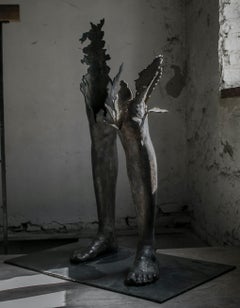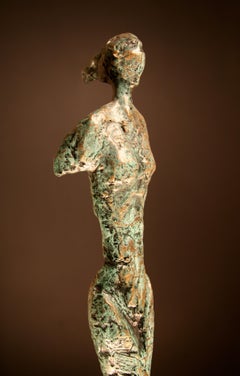Digital Abstract Sculptures
to
5
1
Overall Width
to
Overall Height
to
6
5
28
14
7
6
5
22
6
3
2
2
6
Medium: Digital
Artist: Michael Kalish
Red Rose on Circle Graffiti
Located in Los Angeles, CA
This is a signed and numbered limited edition of 18. Commission Only, lead time is apx. 5 weeks. This dimensional wall sculpture is created with layered laser cut aluminum pieces pai...
Category
2010s Digital Abstract Sculptures
Materials
Enamel, Metal
Price Upon Request
Crush - Rose on Coral
Located in Los Angeles, CA
Michael Kalish is an internationally acclaimed mixed-media artist based in Los Angeles. His passion for metal started with vintage car parts and license plates and evolved to more re...
Category
2010s Abstract Digital Abstract Sculptures
Materials
Enamel, Metal
Price Upon Request
Crush- Rose on Gold
Located in Los Angeles, CA
Michael Kalish is an internationally acclaimed mixed-media artist based in Los Angeles. His passion for metal started with vintage car parts and license plates and evolved to more re...
Category
2010s Abstract Digital Abstract Sculptures
Materials
Enamel, Metal
Price Upon Request
Crush - Rose on Red
Located in Los Angeles, CA
Michael Kalish is an internationally acclaimed mixed-media artist based in Los Angeles. His passion for metal started with vintage car parts and license plates and evolved to more re...
Category
2010s Abstract Digital Abstract Sculptures
Materials
Enamel, Metal
Price Upon Request
Crush - Rose on Pink
Located in Los Angeles, CA
Michael Kalish is an internationally acclaimed mixed-media artist based in Los Angeles. His passion for metal started with vintage car parts and license plates and evolved to more re...
Category
2010s Abstract Digital Abstract Sculptures
Materials
Enamel, Metal
Price Upon Request
Crush- Rose on Blue
Located in Los Angeles, CA
Michael Kalish is an internationally acclaimed mixed-media artist based in Los Angeles. His passion for metal started with vintage car parts and license plates and evolved to more re...
Category
2010s Abstract Digital Abstract Sculptures
Materials
Enamel, Metal
Price Upon Request
Related Items
"Viewer" Bronze Sculpture 41.5" x 32 "x 20" inch Ed. 1/1 by Sergii Shaulis
Located in Culver City, CA
"Viewer" Bronze Sculpture 41.5" x 32 "x 20" inch Ed. 1/1 by Sergii Shaulis
2020
From the Fateful Flowers series
Approximate weight 75 lbs
ABOUT ARTIST
Born on 27 May 1985 in Kharkiv, Ukraine. From 2005 to 2011 studied at the Kharkiv State Academy of Design and Arts, at the Faculty of "Fine Arts" specialty "Easel and monumental sculpture." Now studying postgraduate at Kharkiv State Academy of Design and Arts. Works are in private collections in Ukraine, Israel, Germany, USA, Australia, Finland, Holland, Spain, Belgium, England.
Education
2002‑2005 Faculty of Engineering and Physics (NTU KhPI)
2005‑2011 Easel and monumental sculpture (KSADA)
2012-2016 postgraduate education (KSADA)
Exhibitions
2007-15 City exhibition HONSKHU. Kharkiv.
2007-14 Ukrainian Exhibition KONSKHU. Kyiv.
2008-11 "The maestro and his students", KSADA. Kharkiv (Audience Award 2009)
2008 11 International Triennial of sculpture. Kyiv .
2009 “Male portrait”, gallery KSADA. Kharkiv .
2009 "You get SMS ", Kharkiv ( Grand Prix "The best sculpture...
Category
21st Century and Contemporary Abstract Digital Abstract Sculptures
Materials
Bronze, Steel
$11,500
H 45.5 in W 32 in D 20 in
Bronze Sculpture “Arise”
By Frank Arnold
Located in Fresno, CA
Frank Arnold is thought by many to be one of the foremost abstract figurative painters and sculptors of our time. He is a living master whose work is considered to be both personal a...
Category
2010s Abstract Digital Abstract Sculptures
Materials
Bronze
Bronze Sculpture “Understander”
By Frank Arnold
Located in Fresno, CA
Frank Arnold is thought by many to be one of the foremost abstract figurative painters and sculptors of our time. He is a living master whose work is considered to be both personal a...
Category
2010s Abstract Digital Abstract Sculptures
Materials
Bronze
1970's Enamel Metal Vasarely Silkscreen Screenprint Axo Kinetic Op Art Sculpture
Located in Surfside, FL
Victor Vasarely (1908-1997)
Axo
This piece is hand signed and numbered
circa 1972-1977
I have seen it described as enamel on steel and enamel on aluminium. it is a serigraph on meta...
Category
1970s Op Art Digital Abstract Sculptures
Materials
Metal, Enamel
Wide Awake
Located in Westport, CT
Steve Bickley creates beautiful metal sculpture and wall reliefs, as well as color prints. In addition, he makes large outdoor sculpture in stainless steel and aluminum.
He has bee...
Category
2010s Abstract Digital Abstract Sculptures
Materials
Metal, Enamel
Woman 4
By Frank Arnold
Located in Fresno, CA
Frank Arnold is thought by many to be one of the foremost abstract figurative painters and sculptors of our time. He is a living master whose work is considered to be both personal a...
Category
2010s Abstract Digital Abstract Sculptures
Materials
Bronze
Bronze Sculpture “Surrender 8”
By Frank Arnold
Located in Fresno, CA
Frank Arnold is viewed as one of the foremost abstract figurative painters and sculptors of our time. He is a living master guided by a personal mission to “turn on a light in the human soul,” through his passionate creation of “Messengers” from his deeper mind connection with Carl Jung's archetypal images, the collective unconscious, and Jungian Synchronicity. These unconscious forms from his deeper mind resonate as personal messages of universal acceptance, reaching out to the viewer. Arnold has been honored as IAD Artist of the year 2018 by International Artist Day, and 2013 FAC Horizon Artist Award. He has exhibited his artwork in numerous galleries, museums, and is in collections worldwide. Arnold divides his working days between oil painting in San Jose del Cabo, Baja Sur...
Category
21st Century and Contemporary Abstract Digital Abstract Sculptures
Materials
Bronze
Indian Contemporary Art by Sumit Mehndiratta - Nailed it series No.163
Located in Paris, IDF
Acrylic paint, textiles and metal on wooden panel, ed. 1/3
Category
2010s Abstract Digital Abstract Sculptures
Materials
Metal
$3,500
H 25.6 in W 50.01 in D 1.97 in
My Cat
Located in BARCELONA, ES
Da sempre sono attratto dagli oggetti semplici, spesso dimenticati o fuori contesto. Riporto alla luce piccoli frammenti del quotidiano – giocattoli, gadget, elementi della cultura p...
Category
2010s Abstract Digital Abstract Sculptures
Materials
Iron, Enamel
Woman 2
By Frank Arnold
Located in Fresno, CA
Frank Arnold is thought by many to be one of the foremost abstract figurative painters and sculptors of our time. He is a living master whose work is considered to be both personal a...
Category
21st Century and Contemporary Abstract Digital Abstract Sculptures
Materials
Bronze
"The Man Without a Rod №3" Bronze Sculpture 26x20x9in Ed. 3/8 by Sergii Shaulis
Located in Culver City, CA
"The Man Without a Rod №3" Bronze Sculpture 26x20x9in Ed. 3/8 by Sergii Shaulis
Limited Edition 3/8
From "The man without a rod" series
Approximate weight 77 lbs.
The artist spent almost ten years of his life in the making of this eight-piece series. It is an introspective representation of what he calls absolute hopelessness. “It's about the emptiness of the soul, but it's also about starting anew; when you feel nothing but finding the power inside of you to stand up and move.”
ABOUT ARTIST
Born on 27 May 1985 in Kharkiv, Ukraine. From 2005 to 2011 studied at the Kharkiv State Academy of Design and Arts, at the Faculty of "Fine Arts" specialty "Easel and monumental sculpture." Now studying postgraduate at Kharkiv State Academy of Design and Arts. Works are in private collections in Ukraine, Israel, Germany, USA, Australia, Finland, Holland, Spain, Belgium, England.
Education
2002‑2005 Faculty of Engineering and Physics (NTU KhPI)
2005‑2011 Easel and monumental sculpture (KSADA)
2012-2016 postgraduate education (KSADA)
Exhibitions
2007-15 City exhibition HONSKHU. Kharkiv.
2007-14 Ukrainian Exhibition KONSKHU. Kyiv.
2008-11 "The maestro and his students", KSADA. Kharkiv (Audience Award 2009)
2008 11 International Triennial of sculpture. Kyiv .
2009 “Male portrait”, gallery KSADA. Kharkiv .
2009 "You get SMS ", Kharkiv ( Grand Prix "The best sculpture project ").
2009 “Gogol-fest”, Museum Arsenal. Kyiv.
2016 "Corpus", Come in gallery, Kharkiv.
2016 KSADA "Loft", Kharkiv.
2017 “Art seasons”, M17. Kyiv.
2017 Gallery "Semiradskiy", Kharkiv.
2017 "Mundi contraria", M17. Kyiv.
2018 "More than sculpture", ArtUkraineGallery. Kyiv.
2018 “Auguste Rodin. "Premonition of the future...
Category
21st Century and Contemporary Abstract Digital Abstract Sculptures
Materials
Bronze
$12,000
H 26 in W 20 in D 9 in
Huge Dorothy Gillespie Colorful Abstract Expressionist Enamel Painted Sculpture
Located in Surfside, FL
Dorothy Gillespie (1920 – 2012)
Ribboned Image X
2001
Metal Ribbon Sculpture, Enamel on Aluminum with colorful striped green ribbons.
Dimensions...
Category
Early 2000s Abstract Expressionist Digital Abstract Sculptures
Materials
Metal, Enamel
$7,500
H 71 in W 21 in D 21 in
Digital abstract sculptures for sale on 1stDibs.
Find a wide variety of authentic Digital abstract sculptures available on 1stDibs. While artists have worked in this medium across a range of time periods, art made with this material during the 21st Century is especially popular. If you’re looking to add Abstract sculptures created with this material to introduce a provocative pop of color and texture to an otherwise neutral space in your home, the works available on 1stDibs include elements of blue, pink, red, purple and other colors. There are many well-known artists whose body of work includes ceramic sculptures. Popular artists on 1stDibs associated with pieces like this include Roxana Azar, Michael Kalish, Jill Parisi, and Lyn Carter. Frequently made by artists working in the Contemporary, Abstract, all of these pieces for sale are unique and many will draw the attention of guests in your home. Not every interior allows for large Digital abstract sculptures, so small editions measuring 0.25 inches across are also available
Recently Viewed
View AllMore Ways To Browse
Oasis Vintage Poster
Octavius Clark
Oil Painting Constantinople
Oil Painting Dog Sleeping
Oil Painting In Bone
Oil Painting Steamship
Oil Painting With Computer
Oil Thomas Creswick
Old English Horse
Old Man Chair
Old World Landscape Painting
Olga Alexandrovna
Olivier Lavorel
On Kawara
Orazio Gentileschi
Original Vintage Bullfight Posters
Oskar Bergman
Otto Altenkirch
